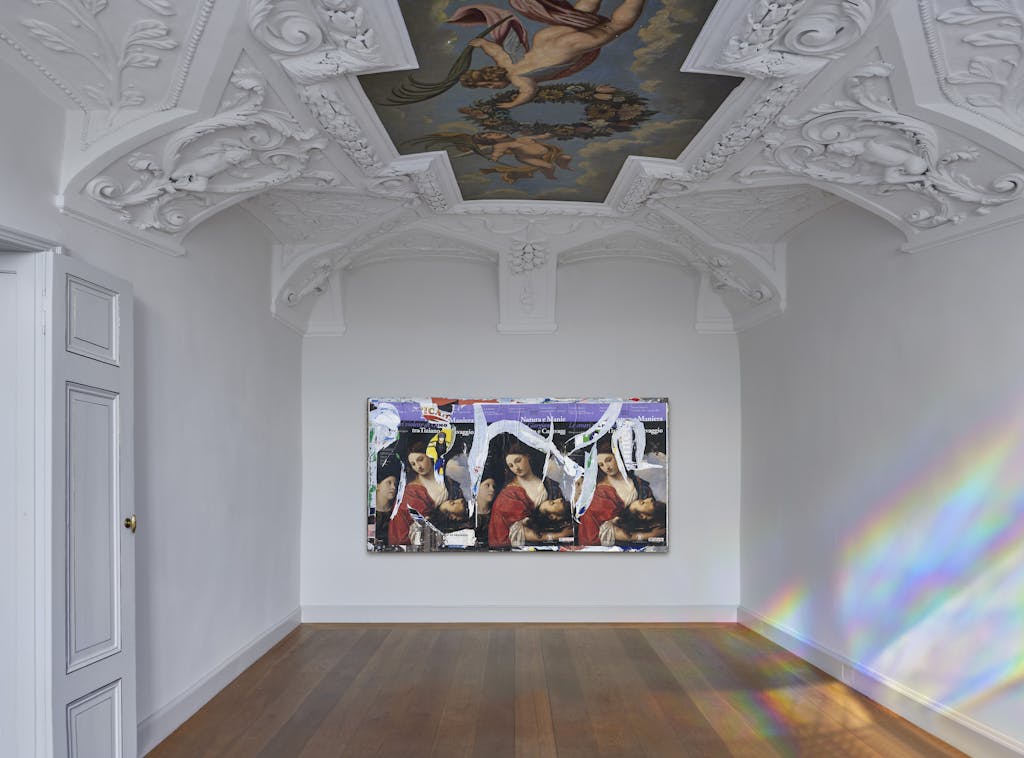Mimmo Rotella
MANIFESTI LACERATI
8 Sep 2023 - 4 Nov 2023
Berlin

The 'décollages' by the Italian Mimmo Rotella (1918–2006) on show in this exhibition impressively present an important chapter in European art history. His works involve the viewer in a perceptual game of coexisting image fragments. Torn advertising posters with colourful images and lettering are familiar to us from our fleeting perception in everyday life, for torn posters (Italian: 'manifesti lacerati'), which are charming and at the same time a little run-down, are omnipresent in the modern city.
Even the beginnings of Rotella's work were marked by protest against a society that had lost its enthusiasm for grandiose changes, whose art was too petit-bourgeois and too self-centred. The technique of tearing down beyond recognition original pictorial contexts has been used by Rotella since he visited an exhibition at the Salon des Réalités Nouvelles in Paris in 1951. With artists like François Dufrêne, Raymond Hains or Jacques Villeglé, the so-called Affichistes wanted to make use of the material that the urban environment offered. It was that which was considered ugly, broken and worthless that was to be elevated to art. On the other hand, that which was traditionally associated with concepts of sublimity and beauty was rejected as radically as the museum as an institution.
Rotella took on a special role as pioneer and ideator within the group that subsequently formed around the critic Pierre Restany as the Nouveaux Réalistes. His work, as the pieces in this exhibition also show, is particularly characterised by intuition and liveliness. Colour, its selection and effect, also seemed to be extraordinarily significant for him.
‘First, I tear my posters off the walls, then from their supports. Impressions, ideas, stimuli pile up in abundance, clashing and accumulating between the first and the last layer. It’s not just about abstract colours confronting each other, but about these colours having a spark, a breath, in a word, having a life of their own. When I include matter in my exploration of colour, it transforms its meaning, the result is dramatic.’
– Mimmo Rotella, Autopresentazione (1957)
So, it was not a matter of haphazard destruction but of new, processual compositions: the selection of motifs, the gluing on of found posters in several layers and finally the tearing off, which is hardly controllable in the result, here down to the substrate of sheet metal or canvas. In addition to the formal aspects, such as the colours and their interaction, the source material, usually advertising posters with lettering or classic film posters, is important, as is the exposed background.
Rotella experimented passionately throughout his life, as a young painter with geometric abstraction, later writing and recording phonetic poetry. However, after developing a photographic projection process (Mec Art), with which he created reproductible, synthetic images, he always returned to décollages, even in later years, no less enthusiastically and, it seems, with a similar energy that drove him earlier.
The posters of films from the 1950s and 1960s now seem almost nostalgic, in 'Marlon' (2004) or 'Dance Dream' (2005) for example. But it is especially in their excerpt-like superimposition that these works prove able to preserve the original medial power of the posters. This still succeeds today, and it succeeds here, detached from the urban context.
A play with time and with the value of images is demonstrated by the extraordinary work 'Vera arte' (2004): three representations of a depiction of Salome by Titian, which served as a motif for an exhibition poster, are lined up in a large horizontal format. With the title of the work (English: True Art), the choice of motif and the element of repetition, Rotella ironically seeks a direct confrontation with the entire history of art – with the old masters as well as with Pop Art
It is particularly such large formats that, as in 'Comunicazioni internazionali' (1992) and 'Incoronata' (2004), underline the claim of Rotella and other Affichistes that that which is degenerate in cities, which hardly receives any attention, is given the status of works of art as images in an exhibition, as monumental fragments of urban landscapes with a new, autonomous value.
When it comes to the appropriation of the source material and its processual post-production, Rotella's works show that they are still relevant today. For they are to be understood as a very direct response to today's consumption of images, especially in view of the constantly growing quantity of images made available and disseminated by the internet. Mimmo Rotella brings the appearance, permanence and disappearance of images into our consciousness and elevates the fragmentary that surrounds us to the value of living beauty.
Mimmo Rotella was born in Catanzaro, Italy, in 1918 and died in Milan in 2006.
Works by Rotella are represented in the following collections, among others: Galleria Nazionale d'Arte Moderna e Contemporanea and Museo d'Arte Contemporanea, Rome; National Gallery of Art, Washington, DC, Los Angeles County Museum of Art, California; Museo del Novecento, Milan; Museum für Moderne Kunst, Vienna; Kunsthalle Mannheim; Centre Georges Pompidou, Paris; Tate Modern, London; Museum Ludwig, Cologne; Sprengel Museum Hannover; Staatsgalerie Stuttgart; Museum of Modern Art, New York; and the Peggy Guggenheim Collection, Venice.